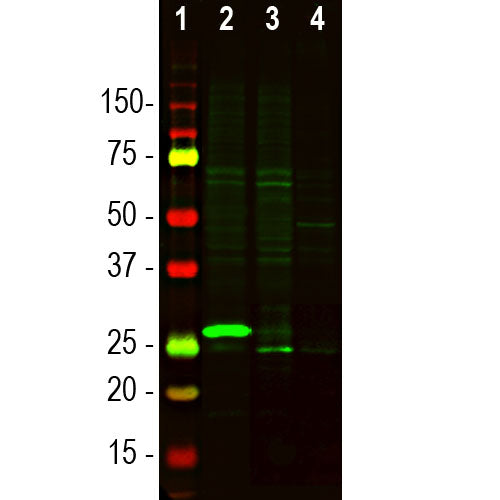

EnCor Biotechnology
Chicken Polyclonal Antibody to Secretagogin, Cat# CPCA-SCGN
Description
The CPCA-SCGN antibody was made against the full length recombinant human secretagogin protein expressed in and purified from E. coli. We document that the antibody works well not only for western blotting, IF and ICC but also on formalin fixed paraffin embedded sections, select the "Additional Data" tab for this data. We also discovered that it is an excellent IHC marker of pancreatic islets. Additionally, we supply a rabbit polyclonal antibody to this protein, RPCA-SCGN.
- Cell Structure Marker
- Cell Type Marker
- Chicken Polyclonal Antibodies
- Developmental Marker
- Immunohistochemistry Verified
Add a short description for this tabbed section
| Immunogen: | Full-length recombinant human secretagogin protein |
| HGNC Name: | SCGN |
| UniProt: | O76038 |
| Molecular Weight: | ~27kDa |
| Host: | Chicken |
| Species Cross-Reactivity: | Human, rat, mouse |
| RRID: | AB_2744521 |
| Format: | Immunogen affinity purified antibody at 1mg/mL in 50% PBS, 50% glycerol plus 5mM NaN3 |
| Applications: | WB, IF/ICC, IHC |
| Recommended Dilutions: | WB: 1:1,000-5,000 IF/ICC and IHC: 1:1,000-1:2,000. |
| Storage: | Store at 4°C for short term, for longer term store at -20°C. Stable for 12 months from date of receipt. |
Secretagogin is a member of the EF-hand superfamily of small Calcium-binding proteins which are widely expressed in cells and tissues. It was first cloned from pancreatic islets of Langerhans and neuroendocrine cells and is highly expressed in theses tissues (1). Initially it is thought to be restricted to neuroendocrine cells, but it is now evident that secretagogin is expressed in numerous brain regions (2,3). The expression pattern of secretagogin is not well conserved from rodents to humans; While human brain reveals an expression maximum in the cerebellum, in rat and mouse brain the highest expression is found in the olfactory bulbs. In the cerebellum the protein is highly expressed in basket and stellate cells. Secretagogin has been shown to be involved in insulin secretion from pancreatic beta cells and is a strong candidate as a biomarker for endocrine tumors (4). Similar to S100β, secretagogin may be a useful biomarker of neuronal damage, stroke, and eventually psychiatric conditions (2,5-7). Moreover, secretagogin has been hypothesized to exert a neuroprotective role in neurodegenerative diseases like Alzheimer’s disease (8).

Chromogenic immunostaining of a formalin fixed paraffin embedded rat brain section (adjacent to the lateral ventricle) with chicken pAb to secretagogin, CPCA-SCGN, dilution 1:2,000, detected with DAB (brown) using the ABC method with citrate buffer retrieval at pH=6.0. Mouse select image for larger view.

Chromogenic immunostaining of a formalin fixed paraffin embedded mouse pancreas section with chicken pAb to secretagogin, CPCA-SCGN, dilution 1:2,000, detected in DAB (brown) detected with DAB (brown) using the ABC method with citrate buffer retrieval at pH=6.0. Hematoxylin (blue) was used as the counterstain. Secretagogin antibody robustly stains the alpha and beta cells of pancreatic islets. Mouse select image for larger view.
1. Wagner L, et al. Cloning and expression of secretagogin, a novel neuroendocrine-and pancreaticis let of Langerhans-specific Ca2+-binding protein. J. Biol. Chem. 275:24740-51 (2000).
2. Gartner W, et al. Cerebral expression and serum detectability of secretagogin, a recently cloned EF-hand Ca2+-binding protein. Cereb. Cortex 11:1161–9 (2001).
3. Mulder J, et al. Secretagogin is a Ca2+- binding protein specifying sub population soft elencephalic neurons. P.N.A.S 106:22492–7 (2009).
4. Ilhan A, et al. Expression of secretagogin in clear-cell renal cell carcinomasis associated with a high metastasis rate. Hum. Pathol. 420:641–8 (2011).
5. Lai M, et al. Secretagogin, a novel neuroendocrine marker, has a distinct expression pattern from chromogranin A. Virchows Arch. 449:402–9 (2006).
6. Adolf K, et al. (2007). Secretagogin is a new neuroendocrine marker in the human prostate. Prostate 67:472–484 (2007).
7. Zurek J, Fedora M. The usefulness of S100B, NSE, GFAP, NF-H, secretagogin and Hsp70 as a predictive biomarker of outcome in children with traumatic brain injury. Acta Neurochir. 154:93–103 (2012).
8. Maj M, et al. Novel insights into the distribution and functional aspects of the calcium binding protein Secretagogin from studies on rat brain and primary neuronal cell culture. Front. Mol. Neurosci. 5.84 (2012).
Add a short description for this tabbed section





